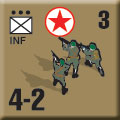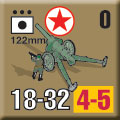| Pusan Perimeter:
The North Korean People's Army
By Mike Bennighof, Ph.D.
October 2019
Kim il-Sung has come to Panzer Grenadier, bearing tanks and other Soviet-supplied weaponry. Korean War: Pusan Perimeter tells the story of the North Korean offensive in the summer of 1950, introducing the North Korean People’s Army or In Min Gun to the series. Korean War: Counter Attack picks up the story in August 1950, with the NKPA's last offensives and subsequent destruction.
 The fighting qualities of the North Koreans would come as a shock their American and South Korean enemies; what had been a small, ragged force of poorly-armed guerillas just five years earlier had become a large, well-trained and well-armed war machine. The North Korean People’s Army was built strictly along Soviet lines, trained by Soviet instructors, and equipped with front-line Soviet Army weaponry. Tens of thousands of them had seen extensive action in the Chinese People's Liberation Army. The early stages of the Korean War would answer the question of how well the United States and its allies might stack up against the Soviets in a hot war: not very well. The fighting qualities of the North Koreans would come as a shock their American and South Korean enemies; what had been a small, ragged force of poorly-armed guerillas just five years earlier had become a large, well-trained and well-armed war machine. The North Korean People’s Army was built strictly along Soviet lines, trained by Soviet instructors, and equipped with front-line Soviet Army weaponry. Tens of thousands of them had seen extensive action in the Chinese People's Liberation Army. The early stages of the Korean War would answer the question of how well the United States and its allies might stack up against the Soviets in a hot war: not very well.
In our Korean War games the North Koreans appear in their own special shade of mud brown, sporting their Texaco friendly star logo. Here’s a look at what they bring to war:
Infantry
   
As with their patron, infantry is the backbone of the NKPA. The rifle platoon carries more submachine guns that the typical Soviet Army formation, with riflemen armed with a variety of weapons: the Moisin-Nagant M1891 bolt-action rifle used by the Red Army and the Imperial Army before it, Japanese-made Arisaka rifles (either captured by the Soviets at the end of World War II or purchased by the Russian Empire during the Great War) and in a few cases the new Soviet-made SKS semi-automatic rifle. The squad light machine gun is the same Degatyerev used in the Great Patriotic War, of several models. A few Japanese-made Nambu models can be found as well.
The heavy machine gun is often the old, reliable Maxim M1910 with its little wheels and shield, and sometimes its replacement, the SG43 Goryunov (which still came with little wheels).
Despite the recent activation of most NKPA units, they include many experienced soldiers – ethnic Korean communists who fought alongside Mao Zedong’s revolutionary armies. Chairman Mao released these men to Kim il-Sing shortly before the outbreak of the Korean War, giving the NKPA a huge influx of tough, dedicated cadres for the upcoming fight.
Tanks
 
The core of North Korea’s striking force is the 105th Armored Brigade, re-styled as an armored division during the course of the campaign. The NKPA received about 120 T-34/85 tanks just before the war. It’s a very capable vehicle, particularly since the United Nations forces have little armor to throw against it during the stage of the war portrayed in Pusan Perimeter. When tanks like the M26 Pershing arrive in the theater it will be a bit different. Yet for now the T-34/85 is both powerful and fast, and can devastate the ill-prepared ROK defenders, who often lack even rudimentary anti-tank weaponry.
Along with their tanks, the North Koreans also have a selection of Soviet-made self-propelled guns. The Su-76 isn’t very good, but when it has no opposition it can do a lot of damage to unsupported infantry.
Recon
 
Earlier editions of Panzer Grenadier didn’t give recon units much to do except move quickly and die easily. That changes with the new Fourth Edition rules, and the North Koreans have the Ba64 to help reveal enemy positions. It’s not very useful otherwise, with only machine guns for armament. They also have horsed cavalry, well-proven in the Great Patriotic War and in the just-concluded Chinese Civil War.
Anti-Tank
  
While it’s not useful against many armored vehicles, the North Koreans have been issued the Soviet PTRD anti-tank rifle in pretty large numbers. While the Soviet Army had a much better infantry anti-tank weapon in the RPG-2 rocket, this had only started to reach the troops in 1949 and was not given to the North Koreans. Only somewhat better is the Red Army’s old standby, the 45mm M1937 anti-tank gun. Already outclassed by enemy armor in 1941, a decade later it’s effective only against halftracks, armored cars and, with some luck, light tanks.
On the positive side, Kim’s men have been issued the Soviet-made ZiS-3 76.2mm divisional gun, an excellent weapon when used as either an anti-tank piece or as light field artillery. The 76.2mm gun is well able to dispose of the Sherman “Easy 8” medium tanks and Chaffee light tanks the Americans bring to Korea in this stage of the war. It also has good performance against the M26 Pershing.
Support Weapons
  
Here the NKPA also follows Soviet doctrine, deploying the 82mm mortar at company and battalion level, and the big 120mm mortar at the disposal of higher-level commanders. The M1937 is a copy of the French-made Brandt 81mm, which in turn gave rise to 81mm mortars built and used all over the world. By the end of the Second World War this weapon provided most of the firepower in most of the world’s infantry battalions, and so it is with the NKPA five years later.
The 120mm M1938 mortar is another copy of a French design, built in huge numbers during the Great Patriotic War and used as an artillery piece as well as an infantry support weapon. But unlike an artillery piece, it can be transported by its crew without the need for a prime mover or animal team, greatly increasing its battlefield utility.
Kim il-Sung's patron, Josef Stalin, once declared that "artillery is the god of war" and he has equipped his protege appropriately. The NKPA is well-armed with 76.2mm, 122mm and 152mm batteries. Or it will be until American air power intervenes.
And that’s about it for the NKPA.
You can order Korean War: Counter Attack right here.
Click here to order Pusan Perimeter.
Sign up for our newsletter right here. Your info will never be sold or transferred; we'll just use it to update you on new games and new offers.
Mike Bennighof is president of Avalanche Press and holds a doctorate in history from Emory University. A Fulbright Scholar and award-winning journalist, he has published over 100 books, games and articles on historical subjects.
He lives in Birmingham, Alabama with his wife, three children and his dog, Leopold. Leopold is a grateful rescued dog.
|
